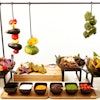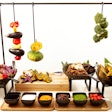
Anise and licorice flavors have been an inspiration for Miami-based Le Basque Catering & Production, like in its lobster caldereta with licorice, saffron, and fennel orzo (pictured). "Pernod, which has licorice undertones, has always been an ingredient found in some lobster bisques and bouillabaisse. So we went further playing with pure black licorice extract and combining it with tomato-based reductions or saffron-based broths," says Alejandro Muguerza, Le Basque president. "We have also been creating ethereal and delicate dehydrated veils of this same ingredient, full of flavor in some dishes (normally with fish and seafood)."
Photo: Courtesy of Le Basque Catering & Production
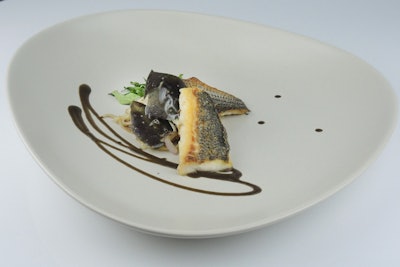
Another Le Basque offering incorporating licorice flavors is a striped bass dish. Spanish cuisine, particularly from the city of San Sebastian, is particularly en vogue right now, and Muguerza says chefs need to find their own interpretation of it. "We don't like following trends," he says. "The moment you do, you cease to create or be original."
Photo: Courtesy of Le Basque Catering & Production
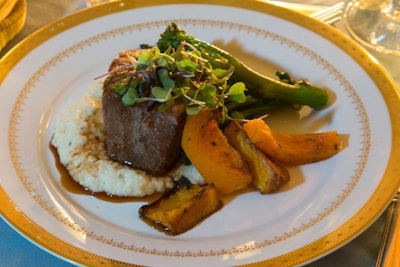
Using locally sourced and foraged ingredients has moved beyond a trend to a way of life at Design Cuisine Caterers in Washington, D.C. "When we do events at George Washington’s Mount Vernon, we make stone-ground grits from grains made at the Gristmill," says C.E.O. Kathy Valentine, pointing to a dish of braised beef short ribs with grits, butternut squash, and charred broccolini. "We continue to discuss what other menu items we can create from products grown on the Mount Vernon estate."
Photo: Courtesy of Design Cuisine
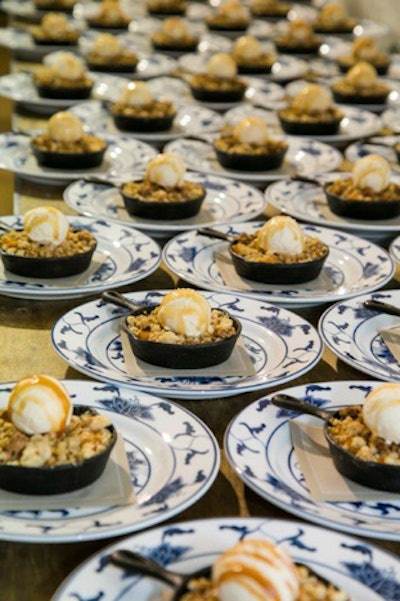
Another ingredient Design Cuisine works with from Mount Vernon is whiskey made in the estate's distillery. It flavors the caramel sauce that tops a grilled peach cobbler with salted caramel ice cream and homemade granola. Chefs also use the spirit in a butterscotch bread pudding with a whiskey foam sauce.
Photo: Courtesy of Design Cuisine

Miami-based caterer and event designer Karla Conceptual Event Experiences is using unrefined coconut oil and raw cashew cream to create a new kind of comfort food. "I am seeing the Miami client beginning to lean away from the trendy heavier foods like fried chicken, pork belly, creamy grits, and short ribs," says owner Karla Dascal. "We are still keeping that comfort element but transitioning into using more vibrant, nutritious ingredients. The richness is still there without the cream and butter. Ingredients like unrefined coconut oil and raw cashew cream are giving richness while pickled young vegetables are giving freshness and creating a balanced dish." One example from Dascal's catering menu is a green risotto with coconut oil, toasted garlic, and ginger, garnished with raw cashew cream, pickled radish, and crispy sweet potato. Chefs fold raw blended spinach and herbs into the rice at the last moment to impart a vibrant green hue.
Photo: Courtesy of Karla Conceptual Event Experiences
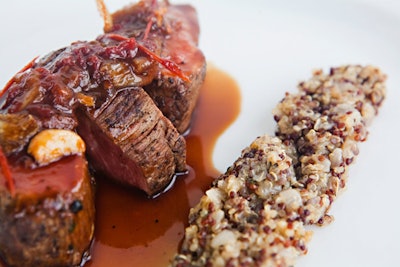
Occasions Caterers in Washington, D.C., is taking ingredients such as smoked garlic and preparing them in new ways to yield new flavor profiles and textures. An example is bison with toasted red and white quinoa, charred tomato, and smoked garlic compote.
Photo: Molly M. Peterson
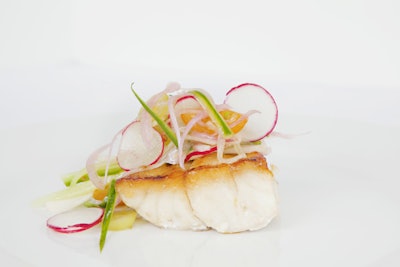
Another new plated dish from Occasions Caterers is Icelandic cod with radish and kohlrabi slaw and yuzu essence.
Photo: Molly M. Peterson
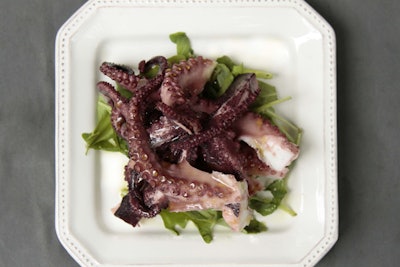
Octopus is having a moment, with more chefs creating dishes with the seafood. After starting as a café and wine bar, Whynot Bistro in New York's West Village debuted a Parisian-influenced menu in October. At the opening, chef Dominick Pepe served baby octopus with olives, potatoes, and arugula, a dish that is on the regular menu.
Photo: Courtesy of Whynot Bistro


